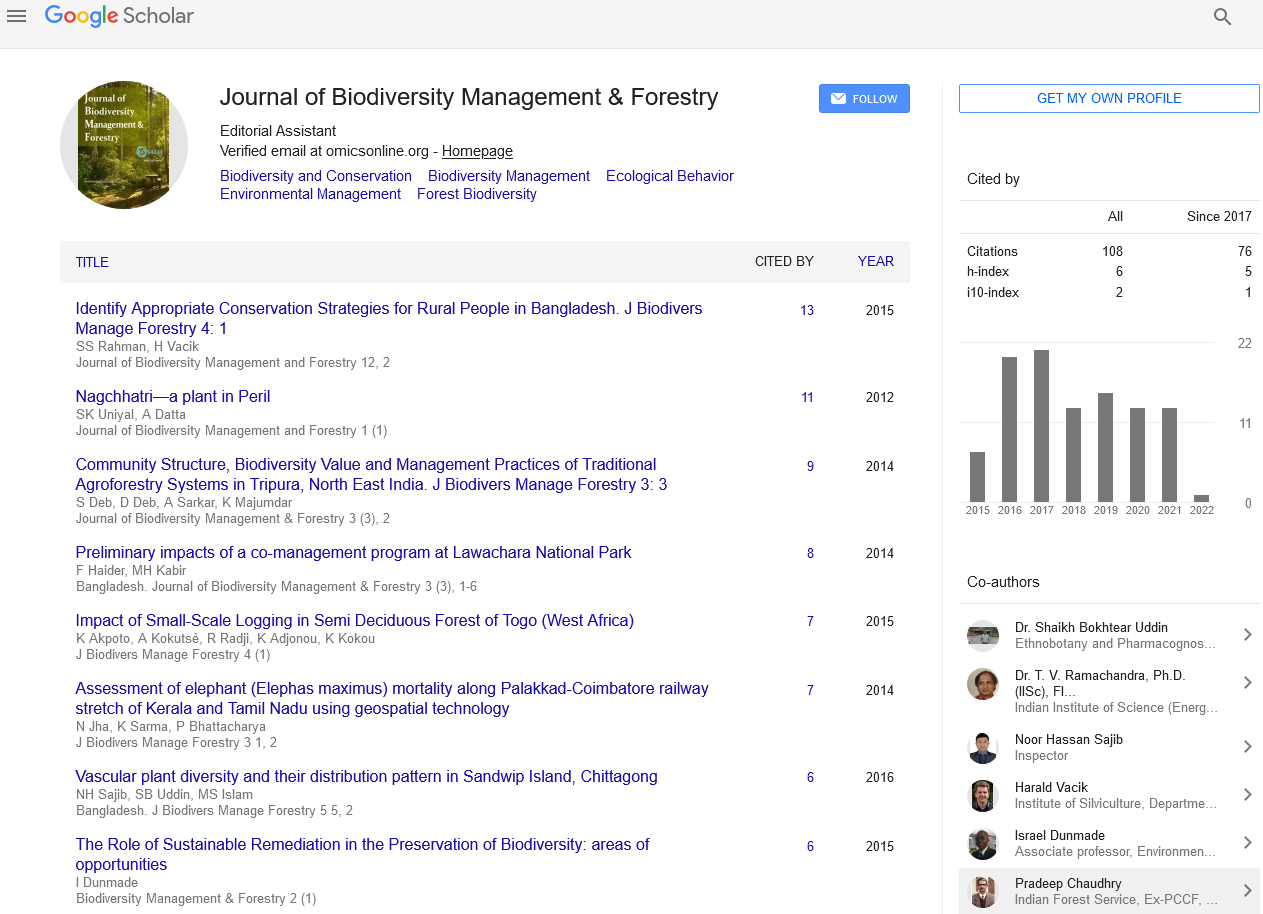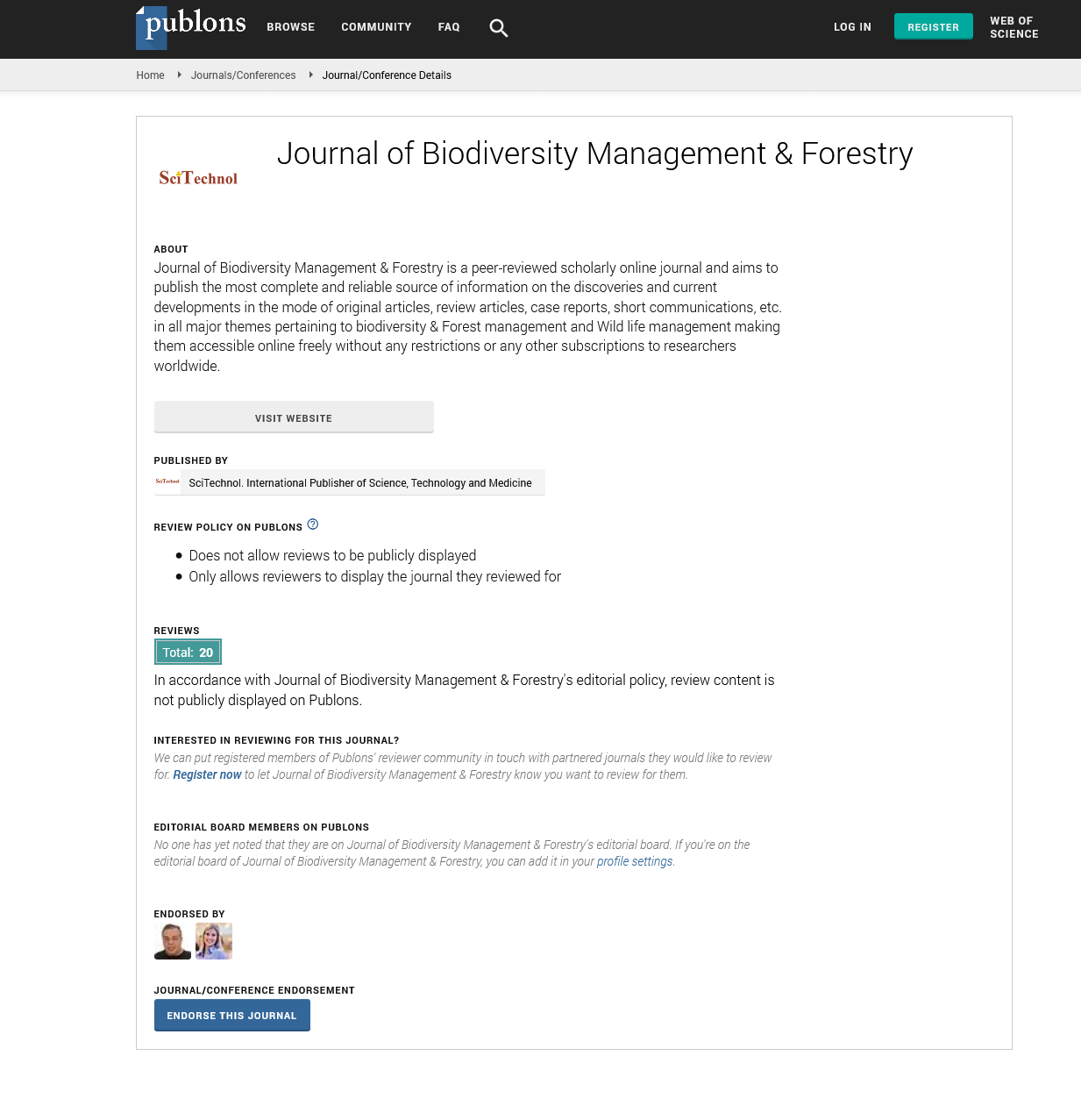Opinion Article, J Biodivers Manage Forestry Vol: 13 Issue: 4
Restoring Ecosystems to Enhance Biodiversity
Rojas Otso*
1Department of Geosciences and Natural Resource Management, University of Copenhagen, Copenhagen, Denmark
*Corresponding Author: Rojas Otso,
Department of Geosciences and Natural Resource Management, University of
Copenhagen, Copenhagen, Denmark
E-mail: rojas.otso@ign.ku.dk
Received date: 25 November, 2024, Manuscript No. JBMF-24-154566;
Editor assigned date: 27 November, 2024, PreQC No. JBMF-24-154566 (PQ);
Reviewed date: 11 December, 2024, QC No. JBMF-24-154566;
Revised date: 19 December, 2024, Manuscript No. JBMF-24-154566 (R);
Published date: 27 December, 2024, DOI: 10.4172/jbmf 2327-4417.1000069.
Citation: Otso R (2024) Restoring Ecosystems to Enhance Biodiversity. J Biodivers Manage Forestry 13:4.
Description
Biodiversity the variety of life on Earth is evaluative to maintaining ecosystem flexibility, providing ecological services and sustaining life. However, human activities such as deforestation, industrialization, pollution and climate change have led to widespread ecosystem degradation, threaten biodiversity worldwide. Ecosystem restoration, the process of repairing and revitalizing damaged ecosystems, has emerged as a vital solution to enhance biodiversity and reverse environmental harm. This study discuss the importance of ecosystem restoration, the challenges involved and the strategies employed to enhance biodiversity.
Degraded ecosystems often fail to support the needs of plants and animals, leading to population declines or extinctions. Restoring ecosystems improves habitat quality, providing shelter, food and breeding grounds necessary for species survival and reproduction. Healthy ecosystems provide essential services such as air purification, water filtration, soil fertility and carbon sequestration. Restoration not only benefits biodiversity but also strengthens these services, directly supporting human livelihoods. Many ecosystems are severely degraded, requiring significant time, effort and resources to restore. Large-scale deforestation, for example, leaves behind barren landscapes that take decades to recover fully. Ecosystem restoration projects are often resource-intensive, demanding funding, manpower and technical expertise. Many regions, especially in developing countries, face financial and logistical barriers to implementing restoration initiatives. Invasive species often dominate degraded ecosystems, making restoration difficult. Eradicating these species while reintroducing native ones is a complex and ongoing challenge. Climate change aggravate restoration efforts by altering ecosystems unpredictably. Rising temperatures, changing precipitation patterns and extreme weather events disrupt restoration processes and hinder species recovery. Restoration projects may face resistance from local communities dependent on degraded land for agriculture, logging, or grazing. Balancing conservation goals with human livelihoods is a evaluative but challenging aspect of ecosystem restoration. Restoration is not a one-time effort but requires long-term monitoring and maintenance to ensure success. Lack of consistent follow-up can lead to project failure, allowing ecosystems to degrade again. Planting trees in deforested or degraded areas is a widely used restoration method. Reforestation helps restore forest ecosystems, enhance biodiversity and combat climate change. Afforestation, planting trees in previously non-forested areas, also contributes to ecosystem revival. Wetlands are biodiversity hotspots and evaluative for water filtration, flood control and carbon storage. Restoring wetlands involves reintroducing native vegetation, improving hydrology and removing pollutants. Coral reefs are among the most biologically diverse ecosystems but face threats from bleaching, pollution and overfishing. Restoration methods include coral gardening, artificial reefs and reducing local stressors. Grasslands are essential habitats for herbivores and pollinators. Restoring grasslands involves replanting native grasses, controlling invasive species and improving soil health. Mangroves are vital coastal ecosystems that protect shorelines, support fisheries and sequester carbon. Restoration involves replanting mangrove trees and improving tidal flow to degraded areas. Removing invasive plants and animals is evaluative for ecosystem recovery. Once removed, native species can be reintroduced to reestablish ecological balance.
Rewilding involves reintroducing key species, often apex predators or keystone species, to restore ecosystem functions. This method helps control overpopulated species and revitalizes ecological interactions. Integrating restoration with sustainable agriculture benefits biodiversity and local communities. Agroforestry, crop rotation and organic farming improve soil health and support pollinators. Establishing Marine Protected Areas (MPAs) safeguards marine ecosystems from overfishing, habitat destruction and pollution. Restoring degraded areas within MPAs allows marine species to thrive. Engaging local communities in restoration projects ensures long-term success. Community-based restoration combines traditional knowledge with modern techniques, promote handling and ownership. Restoring ecosystems is a powerful tool for enhancing biodiversity and addressing environmental challenges. By reviving habitats, reintroducing native species and engaging communities, restoration efforts contribute to ecological balance, climate flexibility and human well-being. While challenges like resource constraints and climate impacts remain, innovative strategies and global cooperation can overcome these obstacles. Restoring ecosystems is not merely an environmental necessity but a moral imperative to ensure the planet’s sustainability for future generations.
 Spanish
Spanish  Chinese
Chinese  Russian
Russian  German
German  French
French  Japanese
Japanese  Portuguese
Portuguese  Hindi
Hindi 
